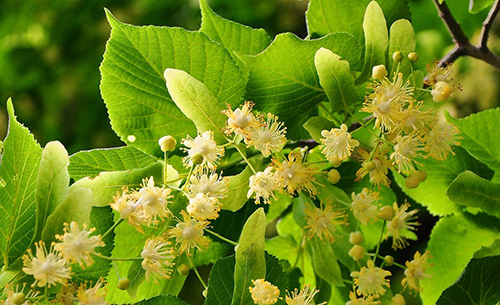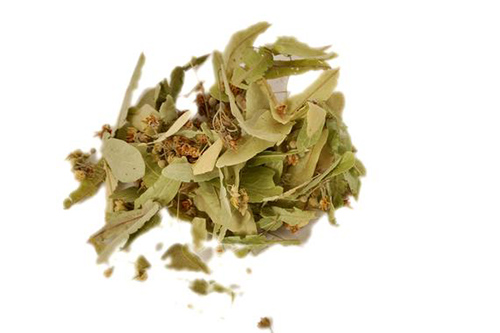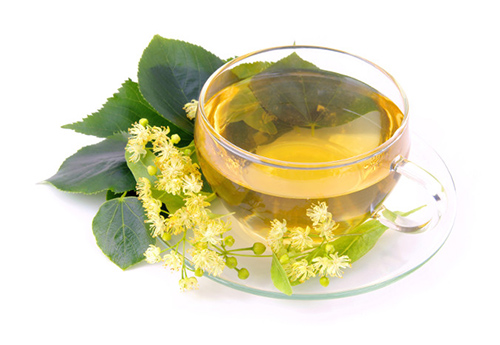Linden flower benefits: Linden are majestic trees that live for several centuries and seem to invite us to live a peaceful and quiet life like theirs. In Central and Northern European countries, the linden symbolizes the family and home life. The use of popular lime tea (an infusion made of linden tree flowers) as a sedative has roots during the Renaissance and is currently one of the most commonly used herbal remedies.
Medicinal Properties

Linden tree FLOWERS contain an aromatic essence rich in magnesium, sedative, antispasmodic, and vasodilating properties. Also, linden flower benefits from mucilages and small amounts of tannins, emollient, anti-inflammatory actions, and flavonoid glycosides, with diuretic and sudorific properties.
The linden tree’s BARK contains polyphenols and coumarin, whose properties are choleretic (augment the secretion of bile), antispasmodic (especially active on the gall bladder), high blood pressure, and vasodilator of coronary arteries.
Linden Flower Benefits
Linden flower benefits are diverse; however, they are due to the plant’s sedative and relaxing effects. Here are some health issues that can be remedied with the use of linden:
Nervous System
Due to their essence, linden flower benefits include help with nervous excitation, anxiety, and restlessness.
- Our linden is sourced artisan farmers. The linden tree’s elegant fragrant flowers produce a light, woody brew which tastes as beautiful as it smells
- A naturally caffeine-free herbal tea that is prized for its subtle floral quality.
- We are thrilled to be able to offer these organic linden flowers – a location renowned for producing the world’s finest linden.
- This herbal tea offers a tantalising glimpse of France’s rich history. Just a sip takes us back to the open fields of the French countryside, surrounded by the heady scent of fresh herbs.
Insomnia
Lime tea effectively combats insomnia and induces restful sleep. It does not produce hangovers the next day. It does not promote addiction, in contrast to the majority of synthetic and sedative medications. However, since this tea is a mild, non-aggressive remedy, it takes time for its benefits to become apparent.
Along with enhancing the benefits of oral Lime tea, warm water baths with linden blossoms offer unique, calming, and soothing qualities. They provide remarkable effects for treating chronic insomnia. Pediatricians also recommend lime tea since it has no harmful side effects. It is perfect for youngsters who are agitated or too active. However, it has to be used for a few days or weeks before it takes effect.
Respiratory Conditions
For children with bronchial catarrhs, bronchitis, asthma, influenza, and chronic coughs, linden blossom is advised due to its mucilaginous components’ emollient activity and antispasmodic characteristics. For a more substantial impact, some bark may be added.
Heart and Circulatory Conditions
Linden’s bark and blooms have vasodilating properties. They are advised for angina pectoris and arrhythmia, which often afflict nervous or worried people who would have a twofold effect from their direct impact on the coronary arteries.
Recent research has shown that linden blossoms and bark thin the blood and improve blood circulation. As a result, it supports thrombosis and heart attack prevention. Consuming linden flowers and bark is especially beneficial for persons with high blood pressure, cardiac conditions, and those prone to heart attacks, arteriosclerosis, and circulation problems.
Migraine
For difficult-to-treat migraine headaches (acute migraines brought on by artery spasms), linden (mainly the bark) is helpful. Since linden is primarily a prophylactic measure, it must be used often, not only when an episode occurs.
Digestive Conditions
Linden, particularly its blossoms, is excellent for those with gallstones or gallbladder dysfunction because of its choleretic and antispasmodic effects on the gallbladder (dyskinesia). It facilitates the removal of gall bladder stones and so-called bile mud (sand in bile). It promotes better digestion in cases of biliary dyspepsia, fat intolerance, gas, or abdominal distention after meals.
- ORGANIC CERTIFIED LINDEN LEAF AND FLOWER- J Mac Botanicals sources dried organic linden leaves from the mountainous border between Albania and Montenegro, a premium herb producing region for organic plants
- PACKAGED IN THE USA – 4 oz of organic Linden leaves and flowers, packaged in a high quality resealable pouch. Packaged in Washington state.
- VERSATILITY – Linden makes a great herbal tea that is naturally caffeine free. Add it to your own herbal tea blends, tictures, infusions, extracts and more.
Skin Conditions
Lime tea has an apparent emollient effect on the skin when applied externally. It is advised for various irritants, eczema, furuncles, and burns.
Beauty Cosmetics
It is crucial in the battle against the adverse effects of the wind, sun, and cold (dry skin, sunburn) on the skin. Its cosmetic use is to calm the skin and enhance its attractiveness. Skin purification and pore opening are benefits of linden steam baths.
Scientific Facts
- Synonyms: Lime tree
- French: Tilleul, til, tillet
- Spanish: Tilo, tila, tejo
- Habitat: Linden grows in the mountainous regions of Europe, the Caucasus region, and Corsica and is wild and farmed. Other varieties grow in America.
- Description: Deciduous, highly branched tree grows to a height of 20m and belongs to the Tiliaceae family. Linden leaves are serrated, heart-shaped, and somewhat asymmetrical. Its flowers are milky or yellowish, with a pleasant scent.
- Parts used: Young flowers and the bark.
Different Linden Trees

There are several linden species worldwide. All of them, except the last we mention, have the same medicinal properties.
- Common linden: Also called white linden (Tillia Platyphylos Scopoli)
- Small-leafed linden: Blooms two or three weeks before the common variety (Tilia cordata Miller)
- European linden: This results from cross-pollination between the former varieties and is the most often used in herbal remedies (Tilia Europea L.)
- American linden: (Tilia Amricana L.)
- Silver linden is an ornamental tree with white leaves on the underside and not used for herbal remedies (Tilia tomentosa Moench. = Tilia argentea D. C.)
Top Rated Linden Products
Preparation and Dosage

- Infusion of flowers: (lime tea). 20-40 g per liter of water. Drink three or four hot cups daily, one before bedtime. Lime tea may be sweetened with honey.
- Bark decoction: 30 g per liter of water; boil for 10 or 15 minutes. It may be mixed with lime tea to obtain a more pleasing effect.
- Fluid extract: The dose usually varies from 20-40 drops, three times a day, with the fourth intake at night before bedtime.
- Linden flower baths: Prepare them with 300-500 g of flowers infused with 1-2 liters of water, added to the bathtub’s water immediately before washing.
- Compresses: Whether for skin diseases or only for beauty, soak compresses in an infusion of 100 g of linden flowers per liter of water, changing the compresses every five minutes. Apply daily two or three times.
Steam Baths

Steam baths are an excellent way to take advantage of linden flower benefits. A linden steam bath is beneficial for treating facial issues. Boil water in a container, remove from heat, and add a handful of linden flowers. You can apply the steam directly to your face. Use this steam bath treatment for two baths daily.
Steam baths with linden flowers soothe the skin and make the face supple. The same infusion is added to the bath water to obtain a relaxing effect, and a complete bath is taken before bedtime. Linden flower baths are very effective against nervousness or insomnia.
DISCLAIMER: All content on this website is presented solely for educational and informational objectives. You should not rely on the information provided as a replacement for advice, diagnosis, or treatment from a qualified medical expert. If you are pregnant, nursing, or have any preexisting medical concerns, you should talk to your doctor before using any herbal or natural medicines.
REFERENCES
- George D. Pamplona-Roger, M.D. “Encyclopedia of Medicinal Plants.” George D. Pamplona-Roger, M.D. Encyclopedia of Medicinal Plants. Ed. Francesc X. Gelabert. vols. 1 San Fernando de Henares: Editorial Safeliz, 2000. 169,170,171. Print. [Linden flower benefits]
- Dr. Axe: “Linden Tea Benefits, Uses, Side Effects and How to Make It” https://draxe.com/nutrition/linden-tea/
- Verywell Fit: “Linden: Benefits, Side Effects, and Preparations” https://www.verywellfit.com/linden-tea-benefits-and-side-effects-4163720
Last update on 2025-04-24 / Affiliate links / Images from Amazon Product Advertising API







